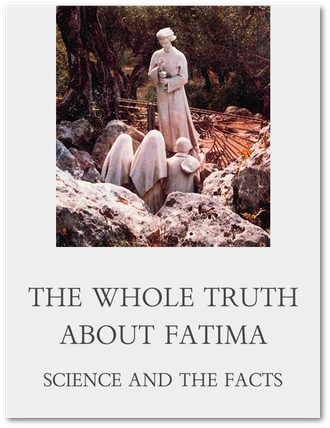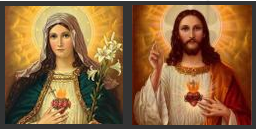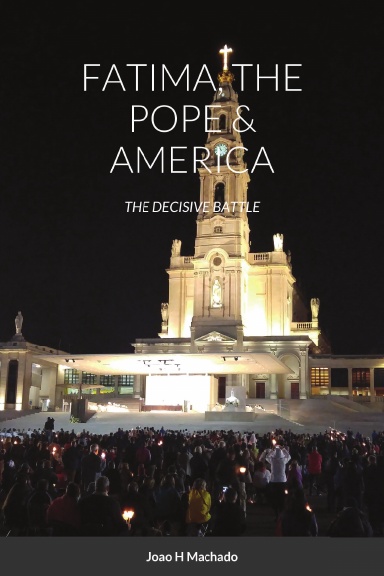916 Q. When and where are the bread and wine changed into the body and blood of Christ?
A. The bread and wine are changed into the body and blood of Christ at the Consecration in the Mass.
917 Q. What is the Mass?
A. The Mass is the unbloody sacrifice of the body and blood of Christ.
918 Q. Why is this Sacrifice called the Mass?
A. This Sacrifice is called the "Mass" very probably from the words "Ite Missa est," used by the priest as he tells the people to depart when the Holy Sacrifice is ended.
919 Q. What is a sacrifice?
A. A sacrifice is the offering of an object by a priest to God alone, and the consuming of it to acknowledge that He is the Creator and Lord of all things.
920 Q. Is the Mass the same sacrifice as that of the Cross?
A. The Mass is the same sacrifice as that of the Cross.
921 Q. How is the Mass the same sacrifice as that of the Cross?
A. The Mass is the same sacrifice as that of the Cross because the offering and the priest are the same -- Christ our Blessed Lord; and the ends for which the sacrifice of the Mass is offered are the same as those of the sacrifice of the Cross.
922 Q. What were the ends for which the sacrifice of the Cross was offered?
A. The ends for which the sacrifice of the Cross was offered were:
- To honor and glorify God;
- To thank Him for all the graces bestowed on the whole world;
- To satisfy God's justice for the sins of men;
- To obtain all graces and blessings.
923 Q. How are the fruits of the Mass distributed?
A. The fruits of the Mass are distributed thus:
- The first benefit is bestowed on the priest who says the Mass;
- The second on the person for whom the Mass is said, or for the intention for which it is said;
- The third on those who are present at the Mass, and particularly on those who serve it, and
- The fourth on all the faithful who are in communion with the Church.
924 Q. Are all Masses of equal value in themselves or do they differ in worth?
A. All Masses are equal in value in themselves and do not differ in worth, but only in the solemnity with which they are celebrated or in the end for which they are offered.
925 Q. How are Masses distinguished?
A. Masses are distinguished thus:
- When the Mass is sung by a bishop, assisted by a deacon and sub-deacon, it is called a Pontifical Mass;
- When it is sung by a priest, assisted by a deacon and sub-deacon, it is called a Solemn Mass;
- When sung by a priest without deacon and sub-deacon, it is called a Missa Cantata or High Mass;
- When the Mass is only read in a low tone it is called a low or private Mass.
926 Q. For what end or intention may Mass be offered?
A. Mass may be offered for any end or intention that tends to the honor and glory of God, to the good of the Church or the welfare of man; but never for any object that is bad in itself, or in its aims; neither can it be offered publicly for persons who are not members of the true Church.
927 Q. Explain what is meant by Requiem, Nuptial and Votive Masses.
A. A Requiem Mass is one said in black vestments and with special prayers for the dead. A Nuptial Mass is one said at the marriage of two Catholics, and it has special prayers for their benefit. A Votive Mass is one said in honor of some particular mystery or saint, on a day not set apart by the Church for the honor of that mystery or saint.
928 Q. From what may we learn that we are to offer up the Holy Sacrifice with the priest?
A. We may learn that we are to offer up the Holy Sacrifice with the priest from the words used in the Mass itself; for the priest, after offering up the bread and wine for the Sacrifice, turns to the people and says: "Orate Fratres," etc., which means: "Pray, brethren, that my sacrifice and yours may be acceptable to God the Father Almighty," and the server answers in our name: "May the Lord receive the sacrifice from thy hands to the praise and glory of His own name, and to our benefit and that of all His Holy Church."
929 Q. From what did the custom of making an offering to the priest for saying Mass arise?
A. The custom of making an offering to the priest for saying Mass arose from the old custom of bringing to the priest the bread and wine necessary for the celebration of Mass.
930 Q. Is it not simony, or the buying of a sacred thing, to offer the priest money for saying Mass for your intention?
A. It is not simony, or the buying of a sacred thing, to offer the priest money for saying Mass for our intention, because the priest does not take the money for the Mass itself, but for the purpose of supplying the things necessary for Mass and for his own support.
931 Q. Is there any difference between the sacrifice of the Cross and the sacrifice of the Mass?
A. Yes; the manner in which the sacrifice is offered is different. On the Cross Christ really shed His blood and was really slain; in the Mass there is no real shedding of blood nor real death, because Christ can die no more; but the sacrifice of the Mass, through the separate consecration of the bread and the wine, represents His death on the Cross.
932 Q. What are the chief parts of the Mass?
A. The chief parts of the Mass are:
- The Offertory, at which the priests offers to God the bread and wine to be changed at the Consecration;
- The Consecration, at which the substance of the bread and wine are changed into the substance of Christ's body and blood;
- The Communion, at which the priest receives into his own body the Holy Eucharist under the appearance of both bread and wine.
933 Q. At what part of the Mass does the Offertory take place, and what parts of the Mass are said before it?
A. The Offertory takes place immediately after the uncovering of the chalice. The parts of the Mass said before it are: The Introit, Kyrie, Gloria, Prayers, Epistle, Gospel and Creed. The Introit, Prayers, Epistle and Gospel change in each Mass to correspond with the feast celebrated.
934 Q. What is the part of the Mass called in which the Words of Consecration are found?
A. The part of the Mass in which the words of Consecration are found is called the Canon. This is the most solemn part of the Mass, and is rarely and but slightly changed in any Mass.
935 Q. What follows the Communion of the Mass?
A. Following the Communion of Mass, there are prayers of thanksgiving, the blessing of the people, and the saying of the last Gospel.
936 Q. What things are necessary for Mass?
A. The things necessary for Mass are:
- An altar with linen covers, candles, crucifix, altar stone and Mass book;
- A Chalice with all needed in its use, and bread of flour from wheat and wine from the grape;
- Vestments for the priest, and
- An acolyte or server.
937 Q. What is the altar stone, and of what does it remind us?
A. The altar stone is that part of the altar upon which the priest rests the Chalice during Mass. This stone contains some holy relics sealed up in it by the bishop, and if the altar is of wood this stone is inserted just in front of the Tabernacle. The altar stone reminds us of the early history of the Church, when the martyrs' tombs were used for altars by the persecuted Christians.
938 Q. What lesson do we learn from the practice of using martyrs' tombs for altars?
A. From the practice of using martyrs' tombs for altars we learn the inconvenience, sufferings and dangers the early Christians willingly underwent for the sake of hearing Mass. Since the Mass is the same now as it was then, we should suffer every inconvenience rather than be absent from Mass on Sundays or holy days.
939 Q. What things are used with the chalice during Mass?
A. The things used with the chalice during Mass are:
- The purificator or cloth for wiping the inside;
- The paten or small silver plate used in handling the host;
- The pall or white card used for covering the chalice at Mass;
- The corporal or linen cloth on which the chalice and host rest.
940 Q. What is the host?
A. The host is the name given to the thin wafer of bread used at Mass. This name is generally applied before and after Consecration to the large particle of bread used by the priest, though the small particles given to the people are also called by the same name.
941 Q. Are large and small hosts consecrated at every Mass?
A. A large host is consecrated at every Mass, but small hosts are consecrated only at some Masses at which they are to be given to the people or placed in the Tabernacle for the Holy Communion of the faithful.
942 Q. What vestments does the priest use at Mass and what do they signify?
A. The vestments used by the priest at Mass are:
- The Amice, a white cloth around the shoulders to signify resistance to temptation;
- The Alb, a long white garment to signify innocence;
- The Cincture, a cord about the waist, to signify chastity;
- The Maniple or hanging vestment on the left arm, to signify penance;
- The Stole or long vestment about the neck, to signify immortality;
- The Chasuble or long vestment over all, to signify love and remind the priest, by its cross on front and back, of the Passion of Our Lord.
943 Q. How many colors of vestments are used, and what do the colors signify?
A. Five colors of vestments are used, namely, white, red, green, violet or purple, and black. White signifies innocence and is used on the feasts of Our Blessed Lord, of the Blessed Virgin, and of some saints. Red signifies love, and is used on the feasts of the Holy Ghost, and of martyrs. Green signifies hope, and is generally used on Sundays from Epiphany to Pentecost. Violet signifies penance, and is used in Lent and Advent. Black signifies sorrow, and is used on Good Friday and at Masses for the dead. Gold is often used for white on great feasts.
944 Q. What is the Tabernacle and what is the Ciborium?
A. The Tabernacle is the house-shaped part of the altar where the sacred vessels containing the Blessed Sacrament are kept. The Ciborium is the large silver or gold vessel which contains the Blessed Sacrament while in the Tabernacle, and from which the priest gives Holy Communion to the people.
945 Q. What is the Ostensorium or Monstrance?
A. The Ostensorium or Monstrance is the beautiful wheel-like vessel in which the Blessed Sacrament is exposed and kept during the Benediction.
946 Q. How should we assist at Mass?
A. We should assist at Mass with great interior recollection and piety and with every outward mark of respect and devotion.
947 Q. Which is the best manner of hearing Mass?
A. The best manner of hearing Mass is to offer it to God with the priest for the same purpose for which it is said, to meditate on Christ's sufferings and death, and to go to Holy Communion.
948 Q. What is important for the proper and respectful hearing of Mass?
A. For the proper and respectful hearing of Mass it is important to be in our place before the priest comes to the altar and not to leave it before the priest leaves the altar. Thus we prevent the confusion and distraction caused by late coming and too early leaving. Standing in the doorways, blocking up passages and disputing about places should, out of respect for the Holy Sacrifice, be most carefully avoided.
949 Q. What is Benediction of the Blessed Sacrament, and what vestments are used at it?
A. Benediction of the Blessed Sacrament is an act of divine worship in which the Blessed Sacrament, placed in the ostensorium, is exposed for the adoration of the people and is lifted up to bless them. The vestments used at Benediction are: A cope or large silk cloak and a humeral or shoulder veil.
950 Q. Why does the priest wear special vestments and use certain ceremonies while performing his sacred duties?
A. The priest wears special vestments and uses certain ceremonies while performing his sacred duties:
- To give greater solemnity and to command more attention and respect at divine worship;
- To instruct the people in the things that these vestments and ceremonies signify;
- To remind the priest himself of the importance and sacred character of the work in which he is the representative of Our Lord Himself. Hence we should learn the meaning of the ceremonies of the Church.
951 Q. How do we show that the ceremonies of the Church are reasonable and proper?
A. We show that the ceremonies of the Church are reasonable and proper from the fact that all persons in authority, rulers, judges and masters, require certain acts of respect from their subjects, and as we know Our Lord is present on the altar, the Church requires definite acts of reverence and respect at the services held in His honor and in His presence.
952 Q. Are there other reasons for the use of ceremonies?
A. There are other reasons for the use of ceremonies:
- God commanded ceremonies to be used in the old law, and
- Our Blessed Lord Himself made use of ceremonies in performing some of His miracles.
953 Q. How are the persons who take part in a Solemn Mass or Vespers named?
A. The persons who take part in a Solemn Mass or Vespers are named as follows: The priest who says or celebrates the Mass is called the celebrant; those who assist him as deacon and sub-deacon are called the ministers; those who serve are called acolytes, and the one who directs the ceremonies is called the master of ceremonies. If the celebrant be a bishop, the Mass or Vespers is called Pontifical Mass or Pontifical Vespers.
954 Q. What is Vespers?
A. Vespers is a portion of the divine office or daily prayer of the Church. It is sung in Churches generally on Sunday afternoon or evening, and is usually followed by Benediction of the Blessed Sacrament.
955 Q. Can one satisfy for neglecting Mass on Sunday by hearing Vespers on the same day?
A. One cannot satisfy for neglecting Mass on Sunday by hearing Vespers on the same day, because there is no law of the Church obliging us under pain of sin to attend Vespers, while there is a law obliging us under pain of mortal sin to hear Mass.





